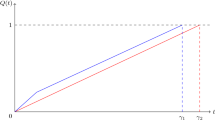Abstract
Consider aG/M/s/r queue, where the sequence{A n } ∞n=−∞ of nonnegative interarrival times is stationary and ergodic, and the service timesS n are i.i.d. exponentially distributed. (SinceA n =0 is possible for somen, batch arrivals are included.) In caser < ∞, a uniquely determined stationary process of the number of customers in the system is constructed. This extends corresponding results by Loynes [12] and Brandt [4] forr=∞ (withρ=ES0/EA0<s) and Franken et al. [9], Borovkov [2] forr=0 ors=∞. Furthermore, we give a proof of the relation min(i, s)¯p(i)=ρp(i−1), 1⩽i⩽r + s, between the time- and arrival-stationary probabilities¯p(i) andp(i), respectively. This extends earlier results of Franken [7], Franken et al. [9].
Similar content being viewed by others
References
I. Akhmarov and N.P. Leont'eva, Conditions for convergence to limit processes and the strong law of large numbers for queueing systems, Teor. Veroyatnost i ee Primenen 21 (1976) 559–570 (in Russian).
A.A. Borovkov, Continuity theorems for multichannel systems with break downs, Teor. Veroyatnost i ee Primenen 17 (1972) 458–468 (in Russian).
A.A. Borovkov,Asymptotic Methods in Queueing Theory (Wiley, Chichester, 1984).
A. Brandt, On stationary waiting times and limiting behaviour of queues with many servers II: the G/GI/m/∞ case, Elektron. Informationsverarb. Kybernetik 21 (1985) 151–162.
A. Brandt, P. Franken and B. Lisek,Stationary Stochastic Models (Akademie-Verlag, Berlin, 1987) to appear.
J.R. Brown,Ergodic Theory and Topological Dynamic (Academic Press, New York, 1976).
P. Franken, Stationary probabilities of states of queueing systems at different times, Engrg. Cybernetics 13 no. 1 (1975) 84–89.
P. Franken, The Point Process Approach to Queueing Theory and Related Topics (Seminarbericht Nr. 43, Sektion Mathematik, Humboldt-UniversitÄt zu Berlin, 1982).
P. Franken, D. König, U. Arndt and V. Schmidt,Queues and Point Processes (Akademie-Verlag, Berlin, 1981).
D. König, K. Matthes and K. Nawrotzki, Unempfindlichkeitseigenschaften von Bedienungsprozessen. Supplement to: B.W. Gnedenko and I.N. Kowalenko,Einführung in die Bedienungstheorie (Akademie-Verlag, Berlin, 1971).
B. Lisek, A method for solving a class of recursive stochastic equations, Z. Wahrscheinlichkeitsth. 60 (1982) 151–161.
R.M. Loynes, The stability of a queue with non-independent inter-arrival and service times, Proc. Cambr. Phil. Soc. 58 (1962) 497–520.
M. Miyazawa, The intensity conservation law for queues with randomly changed service rate, J. Appl. Prob. 22 (1985) 408–418.
T. Nakatsuka, The substability and ergodicity of complicated queueing systems, J. Appl. Prob. 23 (1986) 193–200.
L. Takacs,Theory of Queues (Oxford University Press, New York, 1962).
K.D. Wirth, On stationary queues with batch arrival, Elektron. Informationsverarb. Kybernetik 18 (1982) 603–619.
Author information
Authors and Affiliations
Rights and permissions
About this article
Cite this article
Brandt, A. On stationary queue length distributions for G/M/s/r queues. Queueing Syst 2, 321–332 (1987). https://doi.org/10.1007/BF01150044
Received:
Revised:
Issue Date:
DOI: https://doi.org/10.1007/BF01150044




